
After seeing blizzards in Texas and stock trends driven by Reddit, you probably don’t need to be told that life can take unexpected turns in a hurry. Now, imagine yourself in front of your computer or TV as a reporter tells you that extreme weather is on the way and it’s critical that everyone — and the signal cuts out. Your lights go dark and your faucets run dry. That all-important cell phone turns into a paperweight the second cellular service vanishes. In that situation, a little bit of old-fashioned tech can make a big difference.
The emergency radios on this list are built to deliver important information in the worst of conditions. Their extended battery life and layers of redundant recharging systems keep them up and running long after other electronics have tapped out. Bonus features increase the value they add to a survival kit. Best of all, there is enough variety for everyone to find what they’re looking for. We picked five of the best emergency radios for this gear guide, so read on to learn more.
Midland ER210
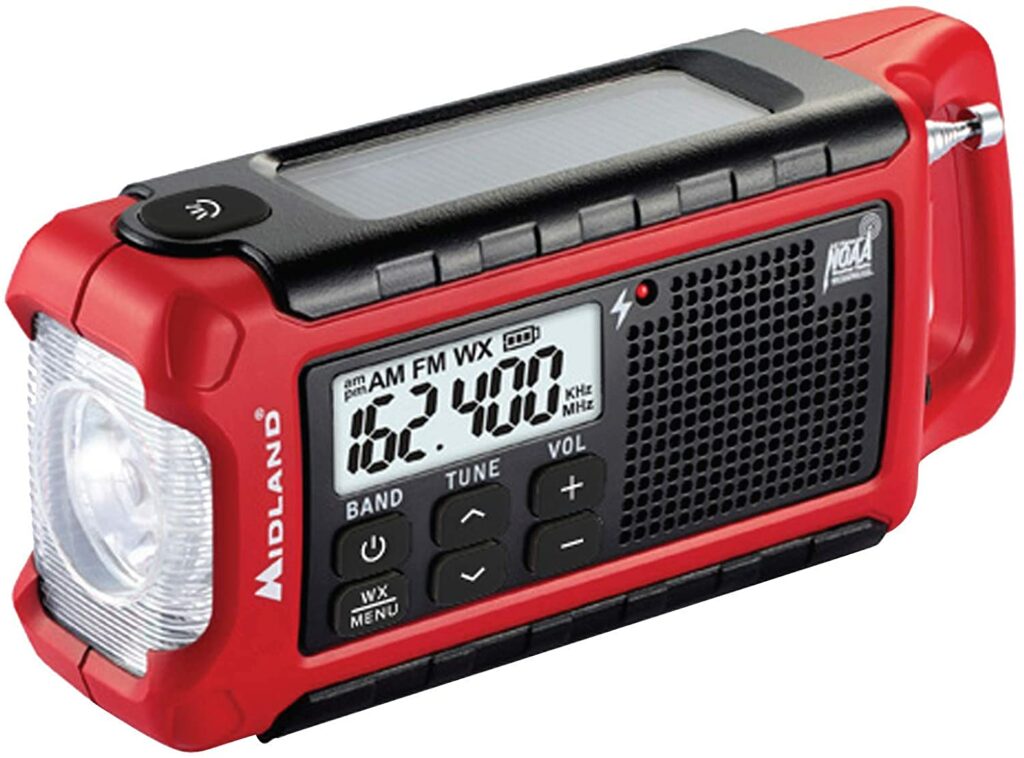
The Midland ER210 delivers the usual emergency radio features in a package that’s compact enough to fit in a hiking or bug-out bag. Its carrying loop is perfect for hanging it off your gear or shelter, too. The internal battery lasts up to 25 hours and can be recharged using its small solar panel or manual crank. The built-in flashlight can be operated in low or high settings, depending on how much light you need and how much battery life you need to preserve. In SOS mode, it will signal for help in Morse code automatically. This radio will scan National Oceanic and Atmospheric Administration (NOAA) weather stations to make sure you don’t miss important information in time to act. If you’re building out an emergency or survival kit, this radio should be a strong contender. For a beefier option, check out Midland’s ER310. [Buy]
RunningSnail emergency weather radio
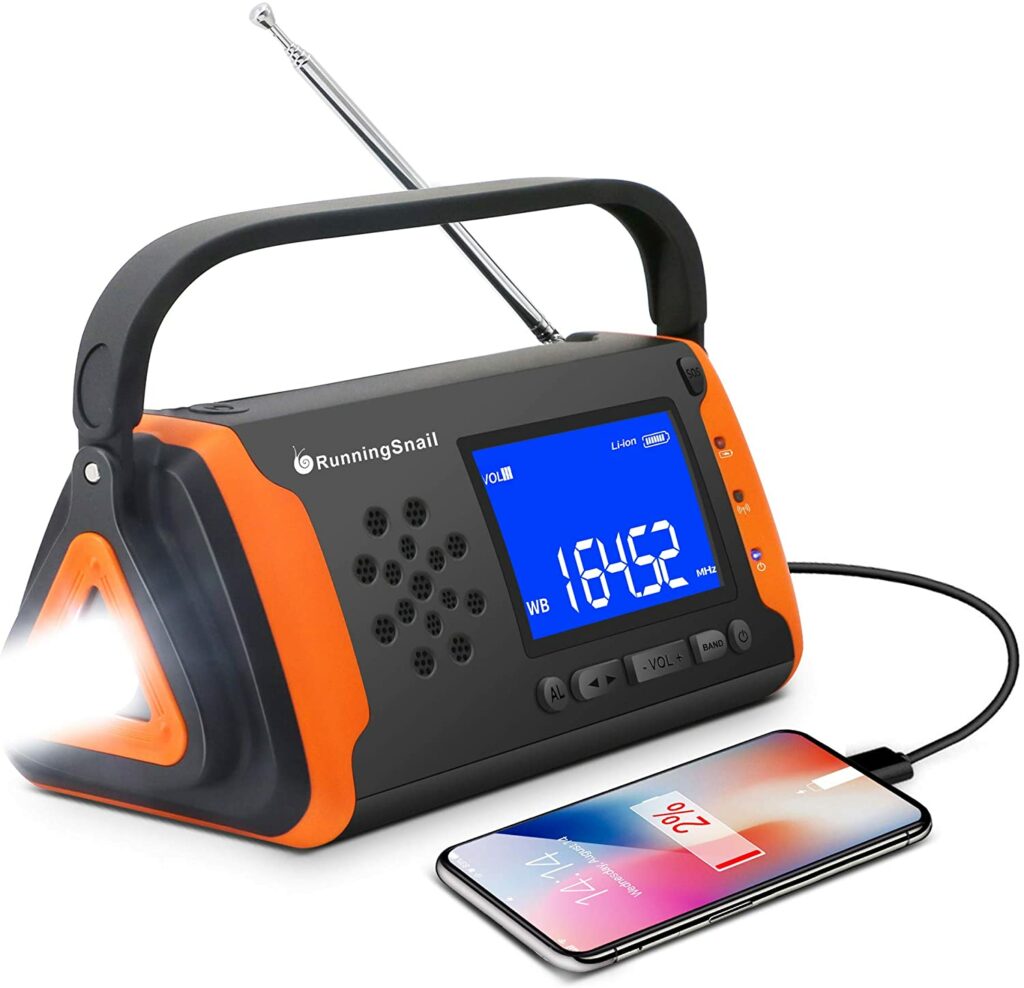
It’s hard to say that any piece of gear is ideal, but this emergency weather radio from RunningSnail comes pretty close. The internal battery packs enough power to keep this radio going longer than many of the alternatives — up to 10 hours of continuous playing time. It also features solar and hand-crank backups. It can also draw power from a power bank using a micro USB cable, or use three AAA batteries. In addition to AM and FM radio signals, it receives NOAA weather alerts to give you an advanced warning before extreme weather hits. The built-in LED flashlight and carrying handle give you one less item to track down when a storm hits. You can even plug in your phone or music player to enjoy your favorite playlist, making this a great option for camping, too. [Buy]
Eton American Red Cross NOAA weather radio
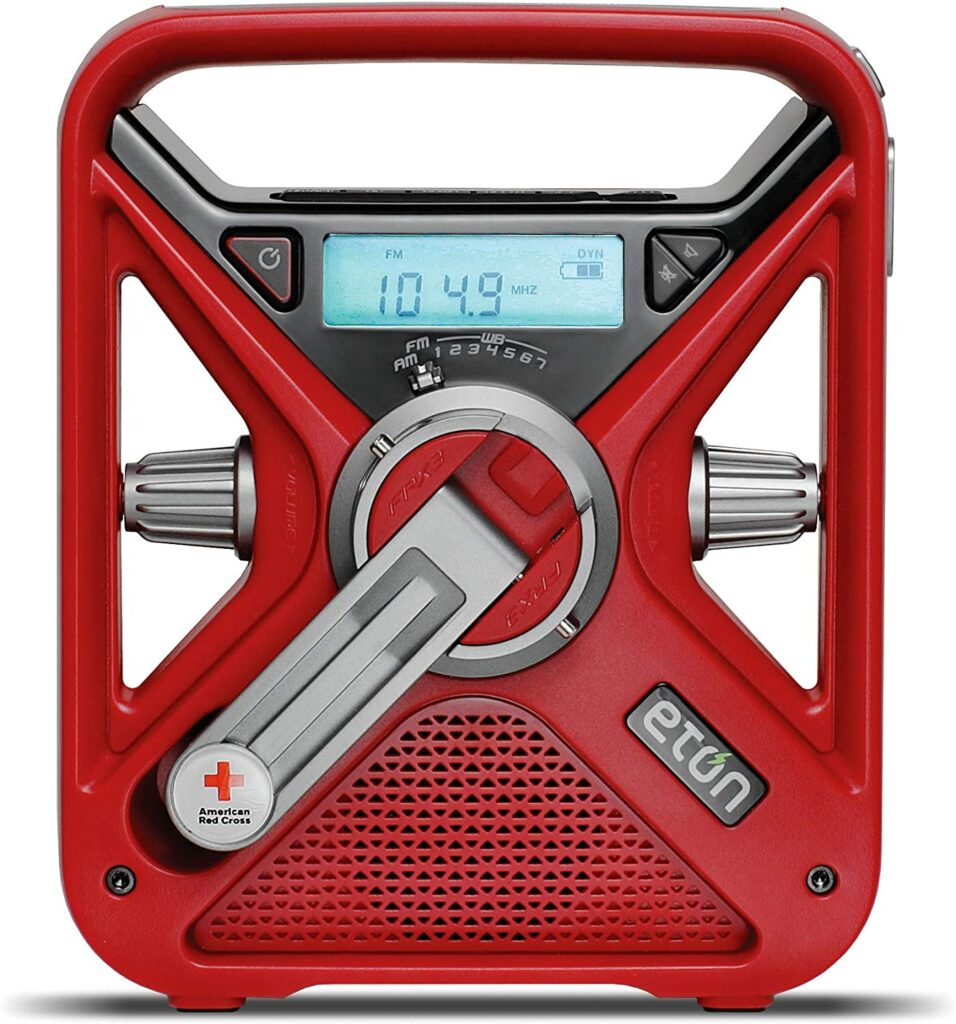
Until the disaster response teams arrive, you can rely on the American Red Cross NOAA weather radio by Eton to keep you up to speed. An automatic alert function places the radio in standby mode until it receives a weather advisory, then turns on to deliver the broadcast. You’ll get access to seven NOAA and Environment Canada bands. Like most emergency radios, it can be charged by hand or using a small solar panel (although, on a radio of this size, we wish the panel was a bit larger). There is also a built-in flashlight and a red flashing emergency beacon. The flattened shape of this radio makes it easy to fit in a survival kit or store in an emergency shelter. Eton offers larger and smaller emergency radios, but this one hits the sweet spot for most people’s needs. [Buy]
PowerBear portable radio
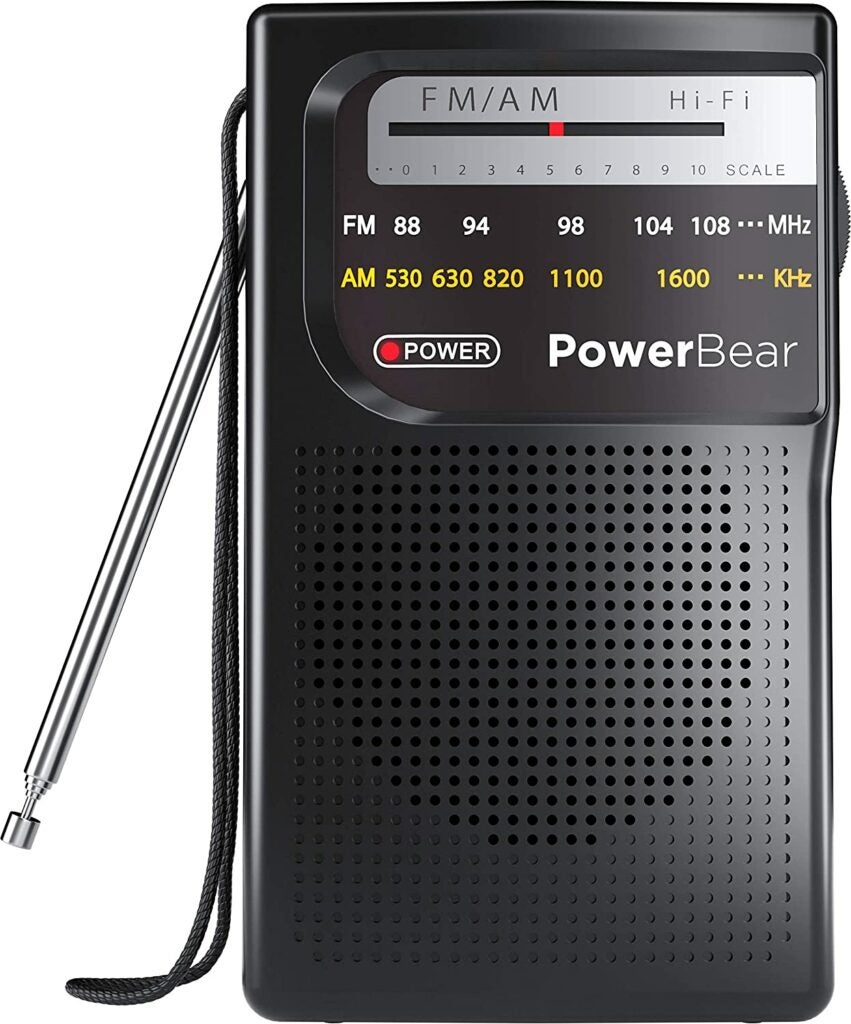
If you’re prepping on pennies, don’t worry — you can still get a PowerBear portable radio to keep you informed when the grid goes down. This is our budget-friendly option, which means it’s a no-nonsense radio that tunes into broadcasts with none of the extra features that would drive the cost up. That also means it can be extremely energy-efficient without the need to power digital displays and external devices. You can pull in AM and FM frequencies for up to 800 hours on a pair of AA batteries. It’s also small enough to fit in your pocket. Even at this price, it comes with a lifetime warranty. If you can do without things like an integrated flashlight, backup charging mechanisms, weather advisory monitoring, and USB charging, this can be a serviceable alternative to more expensive emergency radios. [Buy]
Kaito Voyager Pro
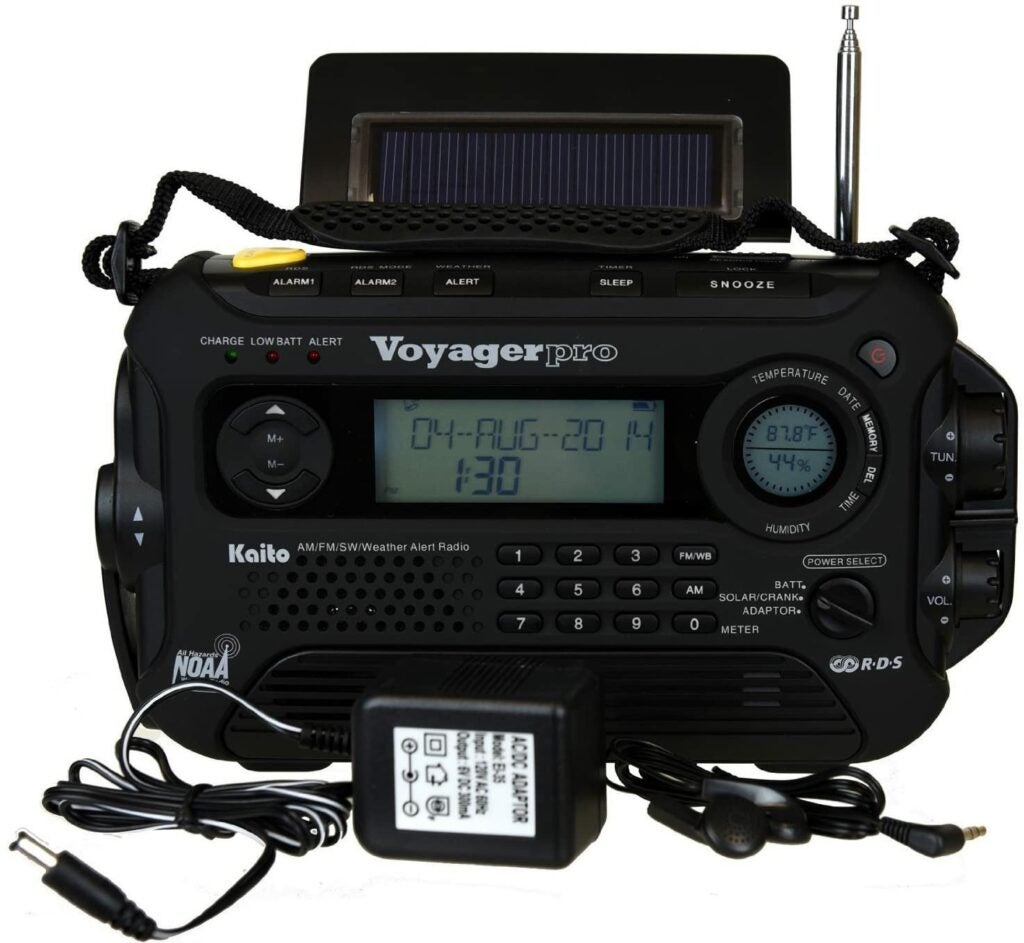
At the top of our emergency radio food chain is the Kaito Voyager Pro. This workhorse has been used by everyone from survivalists to domestic and foreign government entities. It can receive AM, FM, longwave, and shortwave signals in addition to NOAA weather advisories. Four tuning methods let you dial in a clear signal and mark it with one of the radio’s 335 memory settings. In addition to the wall charger, you can use a hand crank and adjustable solar panel to keep the battery charged. A reading light and flashlight are both built-in. The digital display also includes a calendar, two alarm clocks, a sleep timer, a thermometer, and a humidity meter. This is the most expensive emergency radio on our list and it’s noticeably heavier than most of the alternatives, but it’s one we’d feel confident about bringing into the most challenging survival scenarios. [Buy]
Related: 5 survival kits that won’t fail you when everything else does
Why should you trust us
I like to consider myself an outdoorsy kind of guy. That gives me a really convenient excuse to drop money on all kinds of hiking packs, skis, and tools. It also means that, in addition to all the adventure gear I review here at Task & Purpose, I try to prepare for the unexpected. While I wouldn’t suggest that any of us need to go full-on prepper, I will say that a few jugs of water and spare batteries have come in handy more than once in my life. I dove into the emergency radio market to weed out the pretenders and only bring you products that I’d personally trust in a crisis.
The most common types of emergency radios
Emergency radios have been around for a long time, and their mission has remained the same: to keep people connected when nature brings its worst. Simple backup radios are still available, but more advanced alternatives provide features that can make life easier and enhance your survival kit. Read up on the different options available to see which is best for your needs and budget.
Battery-powered radio receivers
In their simplest form, emergency radios just need to establish one-way communication from the outside world in the form of a battery-powered radio receiver. You can pull in your local radio stations without worrying about plugging in your radio, connecting to WiFi, or finding cellular service.
These old-school radios are simple and reliable, but they aren’t fancy. You won’t get secondary features like flashlights and USB connections to charge other devices. They aren’t programmed to automatically broadcast weather advisories from NOAA. On the other hand, they’re extremely affordable and easy to operate. This type of emergency radio is great for locations that don’t experience extreme weather but might lose power now and then.
Sustainable emergency radios
Having an emergency radio is great, but what happens when the batteries die? That’s a very real possibility if you live in an area that experiences hurricanes, tornadoes, or floods. Being able to generate power can extend the life of your emergency radio far beyond the point when depleted batteries would leave you stranded.
This list includes options with solar panels that can top off rechargeable batteries inside the emergency radios. Leave them exposed to sunlight to keep power flowing even when batteries and wall outlets aren’t available. When sunlight is insufficient, you can turn a hand crank to manually generate electricity. This isn’t the easiest or most efficient way to charge a radio, but it’s nice to know that you always have access to power, no matter what.
Weather radios
While all emergency radios have the ability to deliver broadcast messages to you in times of need, weather radios offer another level of capability by automatically broadcasting messages about local weather events directly from NOAA. With this feature, you can leave your radio plugged in around the clock to receive advanced warnings about extreme weather in your area. When that happens, you’ll have a fully-charged battery and time to prepare.
This feature doesn’t come with a noticeable increase in price and is very common in today’s emergency radios. We strongly recommend prioritizing it if you frequently experience severe weather.
Features to look for in emergency radios
When the time comes to augment your survival kit with an emergency radio, you’ll need to consider factors like price, capabilities, and the circumstances that are most likely to make you use your radio.
We’re happy to report that none of the emergency radios on this list are what we’d consider prohibitively expensive. For less than $100, you can get a premium emergency radio. For less than half of that, you can get a quality product that we’d trust enough to include in our own survival kit.
Most emergency radios share a few common features, but there are some differences. Think about whether you’d prefer a reading light or flashlight. Are weather alerts important to you, and do you want to have the ability to take on-site weather readings? Answer these questions to help narrow down your search.
Do you need an emergency radio?
Emergency radios are very common in places that frequently experience extreme weather. If you’ve ever experienced a hurricane, tornado, flood, or blizzard, you know how quickly your connection to the outside world can become compromised. Having a radio that isn’t reliant on your home’s power can be critical to getting the information you need to stay safe.
In addition to a reliable radio signal, emergency radios can provide a sustainable battery backup for your cell phone, a flashlight to light the way, and valuable weather instruments. These versatile tools are one of the most valuable assets you can have in an emergency or survival kit, and their prices are surprisingly affordable.
- Stay informed when hard lines, internet, and cellular service fail
- Receive NOAA updates about dangerous weather in your area
- Add multiple tools to your survival kit in one compact device
- Solar panels and hand cranks keep emergency radios up and running longer than battery-powered devices
Price ranges for emergency radios
- Less than $30: Entry-level radios will provide the bare necessities. Expect a radio, a battery backup, and nothing else.
- Between $30 and $75: Most emergency radios fall into this price range and come with things like flashlights, solar panels, and auxiliary jacks for external devices.
- More than $75: Premium emergency radios up the ante with high-end features like built-in sensors for temperature and humidity. These radios are durable and capable but tend to be heavier than most.
How we chose our top picks
In an ideal world, we would put every product we review through a series of rigorous hands-on tests to see exactly what they’re made of. Unfortunately, that isn’t always an option. When limited time and resources get in the way, we turn to the thousands of customers who have purchased these products and shared their experiences. By consulting crowd wisdom in the form of reviews and ratings, we’re able to identify the best-performing products on the market and recommend them to you.
Related: 5 emergency blankets that every adventurer should own
Task & Purpose and its partners may earn a commission if you purchase a product through one of our links.
The post Create a lifeline with the best emergency radios appeared first on Task & Purpose.
